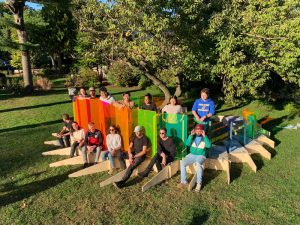Earlier this year, a team of dedicated students and young professionals, in collaboration with Grimshaw Architects, schlaich bergermann partner, and Hofstra University, ran a successful design-build workshop and construction project with funding support from the SEI Futures Fund. The project, an adaptation of projects by Scale Rule in the UK, organized the workshop, design process, and construction to inspire students and nurture the creativity, understanding, and problem-solving skills at the core of structural engineering practice. Project goals included learning collaborative interdisciplinary design and communication skills to encourage more engineers, more diverse engineers, and engineers with a changing skill set.
Twenty-four high school students, invited through their schools and youth organizations, attended the workshop at Hofstra. The program included presentations on the AEC industry, key principles of a structural load path, and architectural sketching. Student teams were challenged to develop a concept design for an interactive pavilion to install on the Hofstra campus, working closely with Hofstra engineering students and industry volunteers to develop sketches and a physical model of their design. Finally, they presented their creative concept designs to a panel of judges from industry and academia, who selected the design for a bench wrapped around a tree with colorful translucent screens.
The workshop volunteers iterated the design to match the construction budget and schedule, explored reused and secondhand materials, and favored design detailing that enabled automated fabrication to allow simple assembly on site. The focus on precision bending and cutting from the material suppliers allowed the design team of young professionals and university students to install the pavilion in less than eight hours. The whole project – from the workshop to the construction of the pavilion – was completed in less than six months.
The project enabled university students and young professionals to share their design insights with a diverse group of high school students. The design process allowed young professionals to engage in engineering on a different scale and level of detail than their typical project work, taking responsibility for material procurement and construction scheduling. The construction process provided young professionals and university students insight into the complications of effectively realizing calculations and designs into physical construction.
Following completion of the pilot project, a resource and instruction guide will be made available as a model for other groups to replicate the program with industry, university, and high school partnerships. Learn more at https://scalerule.org/building-the-next-engineers.

